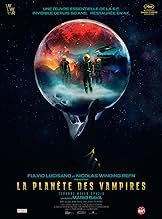IMDb-BEWERTUNG
6,2/10
7407
IHRE BEWERTUNG
Nach der Landung auf einem geheimnisvollen Planeten beginnt ein Team von Astronauten, sich gegeneinander zu wenden, beeinflusst durch den ungewissen Einfluss des Planeten und seiner seltsame... Alles lesenNach der Landung auf einem geheimnisvollen Planeten beginnt ein Team von Astronauten, sich gegeneinander zu wenden, beeinflusst durch den ungewissen Einfluss des Planeten und seiner seltsamen Bewohner.Nach der Landung auf einem geheimnisvollen Planeten beginnt ein Team von Astronauten, sich gegeneinander zu wenden, beeinflusst durch den ungewissen Einfluss des Planeten und seiner seltsamen Bewohner.
- Auszeichnungen
- 1 Nominierung insgesamt
Ángel Aranda
- Wess Wescant
- (as Angel Aranda)
Federico Boido
- Keir
- (as Rico Boido)
Vito Fasano
- Dead Galliott Crew Member
- (Nicht genannt)
Giuseppe Mattei
- Brent
- (Nicht genannt)
Handlung
WUSSTEST DU SCHON:
- WissenswertesThis film marks the first collaboration between Mario Bava and his son/assistant director Lamberto Bava. Lamberto would later become a director himself.
- PatzerWhen Toby and Mark duke it out, Toby bumps into and moves the flight seat revealing it to be unattached to the deck.
- Zitate
Capt. Mark Markary: I'll tell you this, if there 'are' any intelligent creatures on this planet... they're our enemies.
- Alternative VersionenThe original Italian version runs 88 minutes long. The US version runs 86 minutes long.
- VerbindungenFeatured in Aweful Movies with Deadly Earnest: The Demon Planet (1969)
Ausgewählte Rezension
I saw this film in it's 1965 American release, and at the time I was not overly impressed. It was obviously made on a low budget, the dialog dubbing is bad (although far superior to some other Italian imports I have seen), the acting alternates between wooden (Barry Sullivan) and outrageously overdone (i.e., "gravity effects", the reaction of the actor who smashes the "meteor deflector", numerous fear reaction shots of crew members). Time has proven that it has become a trend setter for numerous subsequent sci-fi films (most notably Ridley Scott's "Alien" (1979)). I recently viewed it again 37 years after it's release, and the similarities to "Alien" are unmistakable. The attentions of the crews of both films are attracted by mysterious radio signals originating from an unexplored world. The horseshoe shape of the ships in POTV resembles that of the wrecked alien spacecraft in "Alien". There are similar shots of the ship's landing gear in both films. Both crews find ancient wrecked spacecraft and skeletal remains of giant aliens on the planets they land upon. There is an unknown predatory alien presence in both films. Lots of gore footage exists in both films too, although POTV unarguably started this trend (alas, is there any recent sci-fi film that does not fall to this temptation?).I cannot believe that all these similarities are coincidental, and I suspect that Dan O'Bannon must have been heavily influenced by POTV, whether he realized it or not.
The use of lighting and color are also noteworthy. POTV still looks good today due to colorful exterior scenes (forgive the somewhat clumsy use of composite shots of the crew in a few scenes set against an obviously miniature landscape). Please also forgive the overzealous use of the zoom lens, which had just been developed at the time. One big demerit in set design comes from a scene inside the wrecked alien spacecraft. A prominently-featured prop appears to be the taillight lens from a 1957 Packard, complete with the backup light lens below it. It is positioned vertically in the shot, and perhaps the set designer was hoping that Italian audiences would not recognize it. Another detractor is the almost unlimited amount of area inside the ships. No ceilings are visible, and the various compartments look as big as football fields when compared to realistic spacecraft design criteria.
I found this to be an entertaining if somewhat flawed film, certainly more enjoyable than it was when I first watched it in 1965. It deserves a vote of 6/10.
The use of lighting and color are also noteworthy. POTV still looks good today due to colorful exterior scenes (forgive the somewhat clumsy use of composite shots of the crew in a few scenes set against an obviously miniature landscape). Please also forgive the overzealous use of the zoom lens, which had just been developed at the time. One big demerit in set design comes from a scene inside the wrecked alien spacecraft. A prominently-featured prop appears to be the taillight lens from a 1957 Packard, complete with the backup light lens below it. It is positioned vertically in the shot, and perhaps the set designer was hoping that Italian audiences would not recognize it. Another detractor is the almost unlimited amount of area inside the ships. No ceilings are visible, and the various compartments look as big as football fields when compared to realistic spacecraft design criteria.
I found this to be an entertaining if somewhat flawed film, certainly more enjoyable than it was when I first watched it in 1965. It deserves a vote of 6/10.
Top-Auswahl
Melde dich zum Bewerten an und greife auf die Watchlist für personalisierte Empfehlungen zu.
Details
- Erscheinungsdatum
- Herkunftsländer
- Sprachen
- Auch bekannt als
- Planet of the Vampires
- Drehorte
- Produktionsfirmen
- Weitere beteiligte Unternehmen bei IMDbPro anzeigen
Box Office
- Budget
- 200.000 $ (geschätzt)
- Laufzeit1 Stunde 28 Minuten
- Sound-Mix
- Seitenverhältnis
- 1.66 : 1
Zu dieser Seite beitragen
Bearbeitung vorschlagen oder fehlenden Inhalt hinzufügen

Oberste Lücke
What is the Brazilian Portuguese language plot outline for Planet der Vampire (1965)?
Antwort



























